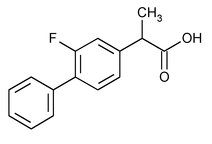Flurbiprofen
(flur'' bi proe' fen).
[1,1¢-Biphenyl]-4-acetic acid, 2-fluoro-
(±)-2-(2-Fluoro-4-biphenylyl)propionic acid
» Flurbiprofen contains not less than 99.0 percent and not more than 100.5 percent of C15H13FO2, calculated on the dried basis.
Packaging and storage—
Preserve in tight containers.
USP Reference standards  11
11 —
—
USP Flurbiprofen Related Compound A RS
2-(4-Biphenylyl)propionic acid.
C15H14O2 226.28
2-(4-Biphenylyl)propionic acid.
C15H14O2 226.28
Identification—
B: Ultraviolet Absorption
Ultraviolet Absorption  197U
197U —
—
Solution:
10 µg per mL.
Medium:
0.1 N sodium hydroxide.
Absorbance maximum at 247 nm is about 0.8.
Melting range  741
741 :
between 114
:
between 114 and 117
and 117 .
.
Loss on drying  731
731 —
Dry it in vacuum at 60
—
Dry it in vacuum at 60 to constant weight: it loses not more than 0.5% of its weight.
to constant weight: it loses not more than 0.5% of its weight.
Residue on ignition  281
281 :
not more than 0.1%.
:
not more than 0.1%.
Heavy metals, Method II  231
231 :
0.001%.
:
0.001%.
Related compounds—
Diluent—
Prepare a mixture of water and acetonitrile (11:9).
Mobile phase—
Prepare a filtered and degassed mixture of water, acetonitrile, and glacial acetic acid (12:7:1). Make adjustments if necessary (see System Suitability under Chromatography  621
621 ).
).
Standard stock solution—
Dissolve an accurately weighed quantity ofUSP Flurbiprofen Related Compound A RS in Diluent to obtain a solution having a concentration of about 50 µg per mL.
System suitability solution—
Pipet 2.0 mL of Standard stock solution into a 10-mL volumetric flask, add about 20 mg of USP Flurbiprofen RS, dilute with Diluent to volume, and mix.
Standard solution—
Transfer 2.0 mL of Standard stock solution to a 10.0-mL volumetric flask, dilute with Diluent to volume, and mix.
Test solution—
Prepare a solution of Flurbiprofen in Diluent containing 2.0 mg per mL.
Chromatographic system (see Chromatography  621
621 )—
The liquid chromatograph is equipped with a 254-nm detector and a 3.9-mm × 15-cm column that contains 4-µm packing L1. The flow rate is about 1 mL per minute. Chromatograph the System suitability solution, and record the peak responses as directed for Procedure: the relative retention times are about 0.9 for flurbiprofen related compound A and 1.0 for flurbiprofen; and the relative standard deviation for replicate injections is not more than 1.0%.
)—
The liquid chromatograph is equipped with a 254-nm detector and a 3.9-mm × 15-cm column that contains 4-µm packing L1. The flow rate is about 1 mL per minute. Chromatograph the System suitability solution, and record the peak responses as directed for Procedure: the relative retention times are about 0.9 for flurbiprofen related compound A and 1.0 for flurbiprofen; and the relative standard deviation for replicate injections is not more than 1.0%.
Procedure—
Separately inject equal volumes (about 20 µL) of the Standard solution and the Test solution into the chromatograph, record the chromatograms, and measure the areas for the major peaks. Calculate the percentage of flurbiprofen related compound A in the portion of Flurbiprofen taken by the formula:
100(CS / CU)(rU / rS)
in which CS is the concentration, in µg per mL, of USP Flurbiprofen Related Compound A RS in the Standard solution; CU is the concentration, in µg per mL, of Flurbiprofen in the Test solution; and rU and rS are the peak responses for flurbiprofen related compound A obtained from the Test solution and the Standard solution, respectively: not more than 0.5% of flurbiprofen related compound A is found. Calculate the percentage of each impurity in the portion of Flurbiprofen taken by the formula:
100(ri / rs)
in which ri is the peak response for each impurity obtained from the Test solution; and rs is the sum of the responses of all the peaks obtained from the Test solution: the sum of all impurities is not more than 1.0%.
Assay—
Dissolve about 0.5 g of Flurbiprofen, accurately weighed, in 100 mL of alcohol, previously neutralized with 0.1 N sodium hydroxide VS to the phenolphthalein endpoint, add phenolphthalein TS, and titrate with 0.1 N sodium hydroxide VS to the first appearance of a faint pink color that persists for not less than 30 seconds. Each mL of 0.1 N sodium hydroxide is equivalent to 24.43 mg of C15H13FO2.
Auxiliary Information—
Please check for your question in the FAQs before contacting USP.
| Topic/Question | Contact | Expert Committee |
|---|---|---|
| Monograph | Clydewyn M. Anthony, Ph.D.
Senior Scientific Liaison 1-301-816-8139 |
(SM22010) Monographs - Small Molecules 2 |
| Reference Standards | RS Technical Services 1-301-816-8129 rstech@usp.org |
USP35–NF30 Page 3257
Pharmacopeial Forum: Volume No. 31(4) Page 1069

